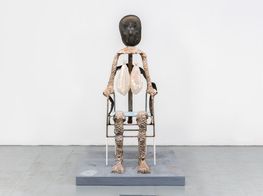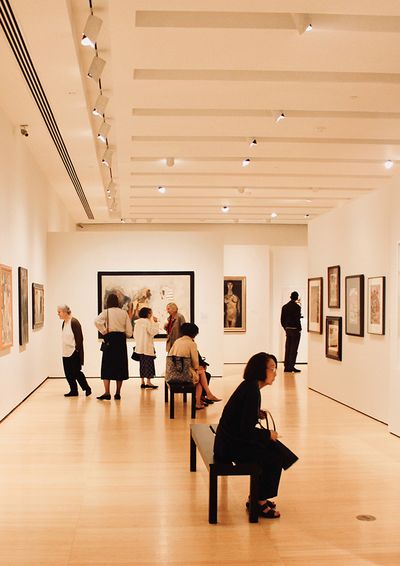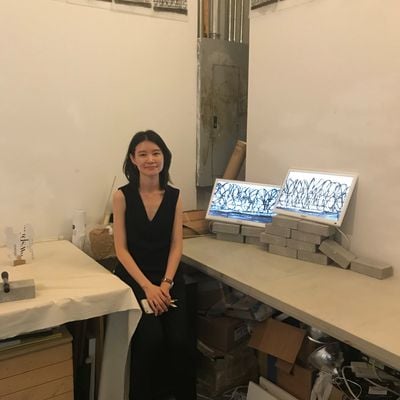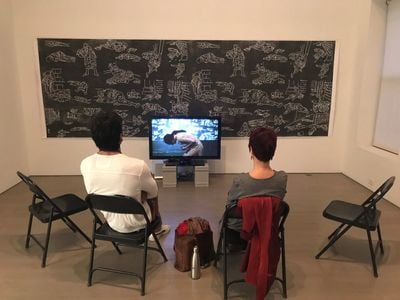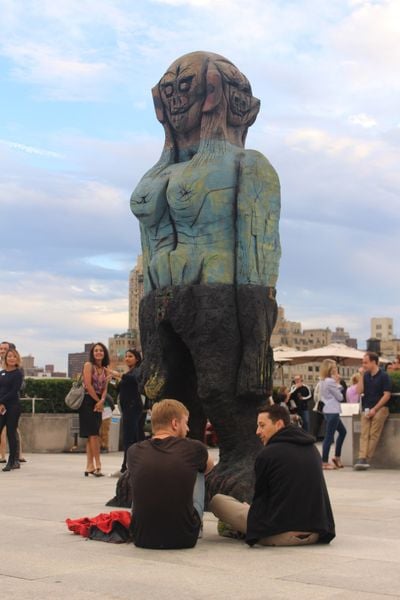Asia Contemporary Art Week: Diary #2: 14–23 September 2018
In collaboration with Asia Contemporary Art Week
Closing out the first week and ushering in the second of Asia Contemporary Art Week's season-long programme of Asia-focused activities throughout New York City were 'Writing the Indian Modern', and 'Collecting the Indian Modern' at Asia Society. The panels were hosted in conjunction with their new exhibition The Progressive Revolution: Modern Art for a New India (14 September 2018–20 January 2019), which was organised by Asia Society Museum director Boon Hui Tan and guest curator Dr Zehra Jumabhoy. Through analytical frameworks and collector perspectives, the two back-to-back discussions focused on a critical art historical period in India: the nation's declaration of independence in 1947, and the creation of India and Pakistan as two distinct, political regions.
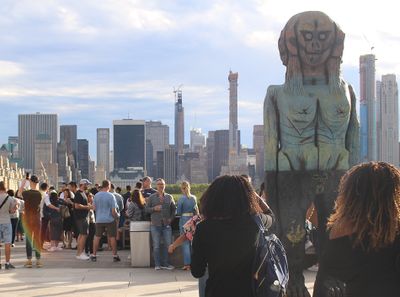
Artist walk-through with Huma Bhabha and The Met Curator Shanay Jhaveri, We Come in Peace, The Metropolitan Museum of Art, New York (17 April–28 October 2018). Courtesy © Asia Contemporary Art Week. Photo: Amera Labib.
Working during this time, the Progressive Artists' Group were a self-selecting group of like-minded radicals, intellectuals, and artists who technically disbanded as a group in 1956, but whose ideals and mantras (heterogeneous, vernacular, unified) spanned two decades on either side of India's independence from Britain. The exhibition (and panel events by design) concentrates on the six core leaders of the group: K. H. Ara, S. K. Bakre, H. A. Gade, M. F. Husain, S. H. Raza, and F. N. Souza. If these names were not familiar ahead of the panel, they felt distinctively recognisable after. The panelists of collectors—Rajiv Jahangir Chaudhri, Taimur Hassan, Dara K Mehta and Kiran Nadar—spoke passionately and convincingly of the unique qualities sought out for each artist, and their participation in a kind of ecosystem of discovery. Jahangir Chaudhri described Souza in particular as a maker of 'difficult work, not fit for the living room' but said that 'he makes the difficult accessible in his own way. Fearlessness meant these artists took new ideas and made them their own'. The question and answer session was dominated by issues surrounding artist survival in the current climate, forgeries and fakes, and whether truly great art can exist in the present.
Another Open Studios session took place on 21 September in Brooklyn's Red Hook neighbourhood. Kakyoung Lee had cleared her studio to fill it with the strangely comforting buzz of ambient wildlife noise, recorded on a summer day at the demilitarised zone on the Korean peninsula. In one corner of the room, a hand-drawn animation of her daughters playing the string game 'cat's cradle' was projected onto a short, makeshift cinder block wall, while pocket flashlights taped to bricks illuminated floating cutout forms - different angles on the same motions of play. 'It's an interesting game,' Lee remarked, 'because you are opponents, but you must collaborate'. Her youth was spent in a small Korean town dominated by an American military presence, and a tour bus trip to the DMZ many years later would prompt her to seek to see and record the vestiges and reality of ongoing conflict. Unable to take photographs at the border, her sound recording reveals a thriving and harmonious ecosystem, devoid of all political association. Two lithography prints on the wall outside in the hallway, barely detectable as different, seem to trace the curling, coiling forms of barbed wire with attentive precision. When asked if her relationship to this image has changed over time, Lee answered, 'I am struck by how circular the shape is, how round, almost heart-like ... sometimes I feel I could just untangle it.'
Farideh Sakhaeifar's studio-like temporary installation at Cathouse Proper gallery featured digitally layered photographs with a looped video exploring the 1988 Halabja anti-Kurdish chemical attack in Iraq through choreographed movements. The attack killed between 3,000 and 5,000 people—largely civilians—during the final days of the Iran-Iraq war. Visitors sat in a semi-circle of chairs, watching as a woman in a nude slip dress and bare feet moved in a slow-motion choreographed sequence through a walled space, backed by spoken English-language narration from survivor testimonies. Isabel Umali, who collaborated with Sakhaeifar to create the film during a Bric residency, explained that before filming, she filled her mind with numerous survivor stories in order to prepare her body for the actions. The result was a falling, rising, writhing, and gently shape-shifting circuit of gestures, somehow alive with the trauma of tragedy. It can be challenging for dance film to translate or even share spoken-word narrative, but this piece could function entirely on its own. A fraught and sinuous test of the body remembering; each dragging foot and twisting hip a kind of monumental metronome. Almost everyone present watched the loop twice. This was paired with a small number of black and white photographs on one wall, which showed historically non-descript scenes of children playing, of the beach, and of ages and stages of innocence, with layered images of limp bodies being carried away by army and medical personnel.
Early on the evening of 22 September, ACAW Director Leeza Ahmady, Shanay Jhaveri, assistant curator of South Asian art at the Metropolitan Museum of Art, and artist Huma Bhabha gathered with a crowd on the roof garden of The Met to talk through Bhabha's site-specific installation, We Come in Peace (2018). The installation comprises two figures that both engage and defy visitors. One, prostrating beneath a black plastic tarpaulin (a body bag, of sorts, or 'a monument to victims'), only hands and part of a crumbling tail visible; and the second, many-faced and towering with tremendous verticality against the New York skyline. Jhaveri explained that the installation contains references to both Indian and European classical works, as well as ideas of monuments and counter-monuments—'they are not on pedestals, and are instead directly on the ground'. Bhabha's figures are iterations of forms she has explored previously, although this is the first time they have a title. 'They have grown as figures,' said Bhabha, 'they are becoming totemic, but they don't walk quickly'. She went on to explain that the variety of media she used—ranging from air-dried clay and charcoal, to polystyrene and plastic—proved an unlikely union and a material challenge. The resulting figures are neither human or animal, male or female, contemporary or historic. With a title referencing the classic sci-fi movie The Day the Earth Stood Still (1951), their resistance to classification adds to both their accessibility and their mystery, leaving open their relationship and purpose, but forced into communication by their vicinity to each other and to visitors.
The second week of ACAW felt like a study in the alchemy of collecting—whether ideas, matter, or individual works—and the power of what is collected to both trouble and reveal. But perhaps more palpable was a shared sense of resilience, and a mindful exploration of the continued relevance of people and places in conflict. The Asia Society panels spoke repeatedly of the historic sociopolitical change through which the Progressive Artists' Group passaged, and how this transition was one of the most compelling reasons for their continued interest in work from this period. This was the creation of a new identity for India, just as Korea's north-south divide has been one of ongoing relevance to artist communities there, and new generations of artists like Sakhaeifar are drawn to atrocities that remain underrepresented in the global sphere. —[O]

